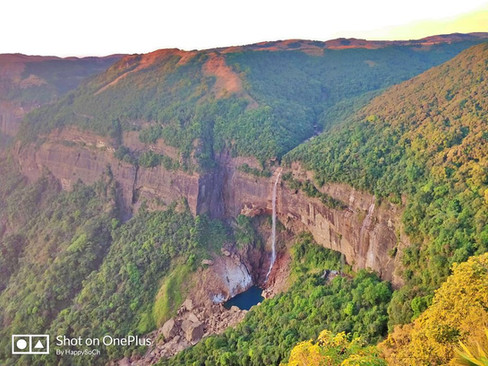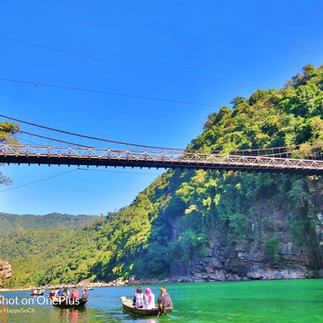Shillong, also referred to as the “Abode of the Clouds” left us mesmerised at the beauty on offer. A trip to Shillong can never be completed without adding on Cherrapunjee & Dawki to the itinerary, which is what we exactly did. Both Cherrapunjee & Dawki are day road trips from Shillong and the best way out is to spread out the visit over 2 days to enjoy both places to the fullest.
The Cherrapunjee diaries:
Cherrapunjee is a high altitude sub-divisional town in the East Khasi hills district in the Indian state of Meghalaya. A sub two hour drive from Shillong makes it one of the most important places to visit for tourists. Cherrapunjee is credited to being the wettest place on Earth and holds the all time record for the maximum rainfall in a calendar month and year. Original name of ‘Sohra’ eventually evolved into the current name of Cherrapunjee – Meaning ‘Land of Oranges’. Notable places to visit in Cherrapunjee include the famous Living root bridges, waterfalls, deep valleys and various caves.

Starting early, we proceeded straight to one of the most arduous as well as mesmerizing sights – The Double Decker Root bridge. The journey from Shillong to Tyrna village (Nongriat) – the starting point for the Double Decker Root bridge, offers some unique landscapes very pleasing to the eye. From patches of pasture lands to cliffs to deep forests all coupled by the plains of Sylhet (Bangladesh) at the distant horizon – it indeed speaks volumes of the enchanting beauty the North East has to offer. All along the journey, we were accompanied by deep mist of clouds and alternate bursts of clear sunny skies.
Double Decker Living Root Bridge – Located in the thick tropical forest of Meghalaya, cloaked with rain for most part of the year lies the fantastic man made & natural wonders of the living root bridges. Created by the people of Khasi tribe, these roots grow from ancient rubber trees in the form of bridges due to the entanglement of roots. Some of the famous living root bridges include Umshiang Double Decker Root bridge, Ummunoi Root Bridge, Ritymmen Root Bridge, Umkar Root Bridge & Mawsaw Root Bridge. We decided to visit the holy grail of root bridges – Umshiang Double Decker Root Bridge. This renowned sight beckons outdoor enthusiasts with an opportunity to see a 150 year+ old man-made natural wonder that’s not only unique but astounding. Almost 3 kilometers of steep trekking one way constituting 3,500 steps and a descent of 2,400 feet, this trek is surely not for the faint hearted. Pro Tip: It is imperative physical condition be taken into account before initiation of this trek which usually takes 5-6 hours to complete. However, the destination is well worth the entire journey. The endless trail of steps took us further and further into the forest. Jack fruit trees were growing wildly amidst the jungle of vegetation.
Crossing a couple of hanging steel bridges over the crystal clean water over rain fed rivers. This is the part of the trek which makes it memorable. The whole bridge is made of rusty iron cables supported with bamboo which shakes and swings with the sight of the river with mighty boulders flowing around 25-30 feet below. Some last round of trek later, we finally chanced upon the much awaited Double Decker Living Root bridge with its gnarly thick roots covered in moss.

The surroundings were serene (only to be interrupted by shouts from fellow travelers) with waterfalls, natural swimming pools, clusters of butterflies, shoal of fish (do try the free fish spa!) mysterious sounds of the forest and so much tranquility and peace. After soaking in the atmosphere for a couple of minutes, we began the task of returning to the starting point. Do hold on to your nerves for the return trek. However, the exceptional encounter with nature is what we treasure the most.
After finishing the trek within 4 hours and having a sumptuous lunch, we proceeded next to visit one of the highest waterfalls in India – Nohkalikai falls, Cherrapunjee. Gushing down from a height of 1100 feet, this waterfall is indeed one of the most visited tourist attractions. A short trek led us to the point from where the panoramic view of the Nohkalikai falls cascading down into a pool like formation can be affluently seen. Noh Ka Likai in local Khasi tribe language means ‘The Leap of Likai’ which translates to a rather sad story of a widow and her daughter. Legend says the widow re-married such that her daughter could get the love of a father. However, the newly wed husband could not stand the daughter and incidents leading to honor killing of the daughter led to the widow to take the leap and give up her life.

Having witnessed one of the most surreal sunsets over the Nohkalikai falls and basked in the wonder of the natural Double Decker living root bridges, we made our way back to our home-stay in Shillong to crash in for the night. Do join us for the third chapter of our trip to Dawki.
The Dawki diaries:
Dawki is a small border town nestled in the West Jaintia hills of Meghalaya. A short 2.5 hour drive from Shillong, the Dawki-Tamabil border crossing between India and Bangladesh is a tourist hot-spot and a must visit for a day outing. Trivia: The new Guwahati-Shillong-Dhaka bus service flagged off by PM Narendra Modi and Bangladeshi counterpart Sheikh Hasina uses this route. However, no sight of border fencing or large battalions of BSF Jawans implied Dawki – Tamabil border to be a ‘Friendly Border’. That said, the relaxed atmosphere is also prone to undocumented, illegal migration (certainly a big issue for India’s North-Eastern states currently). However, all the politics can be brushed aside considering the beauty of the river Umngot – which flows through Dawki. Considered as one of the cleanest rivers in India, Umngot river forms a natural divide between the Jaintia & Khasi hills. In fact, the water of river Umngot is so crystal clear, that seen from distance, it appears the boats are floating in mid-air. The single span suspension bridge hanging over the Umngot river adds to the charm of the place.

The Umngot river has over the years developed into a prime venue for both trade and transport across borders as well as tourism. The Umngot itself is a prime fishing spot for fishermen from adjoining areas. The emerald green color of the river dazzled under the sun and was equally accentuated by the colorful boats lined up along its shores. Gliding down the river in a snake boat is one of the must activities to be done at Dawki. The river bed was strewn with deep round pebbles and stones of various shapes. Around the glistening river were many mysterious alcoves – with their moist walls and tiny grooves. The only sounds of the valley were the gentle swishing of the river and melodious calls of the birds. After a short trip upstream, we returned back to the starting point – also known as the Jaflong Zero Point (where River Umngot crosses over to Bangladesh). The boat ride on the emerald green waters of Umngot was accompanied by the usual chatter of the Khasi boatman who provided further evidence of the intermingling border population. Overall, the experience was one to cherish for a lifetime.
Winding up by mid afternoon, we made our way back to the city center of Shillong to catch up on the festive spirit offered by the Christmas eve. The journey from Dawki to Shillong is such a splendid drive passing through deep gorges and ravines. The West Jaintia hills added a touch of finesse to the entire journey. The rays of sunshine peeping through the vast expanses of clouds floating across the winter sky made the journey worthwhile. Equally inter-spaced were meadows and grasslands whom we were flying past. There are a number of viewpoints across the entire route which offers breath-taking views of the green hills. Before continuing to spend the evening exploring Shillong, we had some piping hot Aloo sabzi and Parathas for our lunch across one of the tiny dhabas adjoining one of the viewpoints.
Shillong has lots to offer in terms of places to visit – Ward’s Lake, Elephant Falls, Shillong viewpoint, Lady Hydari park, Police Bazaar, museums and much more. We first made our way to Wards Lake – a scenic green park with flowering gardens in the Lachumiere area of Shillong. The enclosed lake also offers boating. After spending time till dusk, we made our way to the most happening place of Shillong – Police Bazaar.
Police Bazaar is the most tourist friendly market of Shillong. In addition to the array of restaurants, hotels and big brand stores, the bazaar also houses a flea market section which is pocket friendly and draws maximum number of tourists to the traditional handicrafts stores, exquisite Meghalaya merchandise, regional apparels, junk jewelry and the likes. What’s better to walk hand in hand in the hustle bustle of the narrow by-lanes of the market and do some shopping? Highly recommended is a visit to Hotel Center Point – one of the most iconic landmarks of Police Bazaar. The views from atop ‘Cloud Nine’ was exquisite to say the least. The entire town decked up for Christmas and the lanes choc-a-bloc with traffic gave us the true feel and essence of visiting Shillong.
Shillong is in entirety one of the hidden gems of Meghalaya & one of India’s most sought after tourist destinations. Shillong’s colonial charm & immense natural beauty is a paradise for nature and heritage lovers alike. The three day trip to Shillong will be etched in our memories for times immemorial.
For all budding travel enthusiasts out there, if you need our travel experiences straight into your inbox, do visit our page and subscribe to us. You can also follow us on Instagram and Facebook to get the weekly dose of travel experiences!!
*FIN*



























































Comments